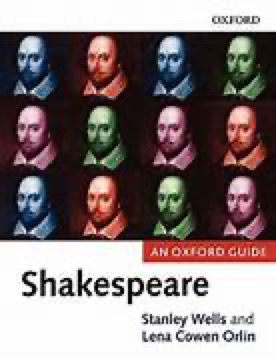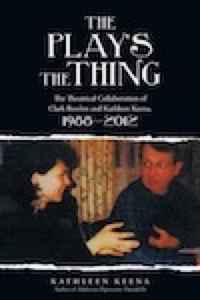Performing Arts
Academic Review - An Oxford Guide: Shakespeare
January/23/2017 10:55 PM Filed: Academic Reviews

Author: Stanley Wells and Lena Cowen Orlin
(Oxford University Press)
An Oxford Guide: Shakespeare
This book is an excellent secondary reference source. Stanley Wells and Lena Cowen Orlin present an overview of Shakespeare’s career from historical and literary standpoints, providing detailed bibliographies. Numerous experts contributed, creating an unbiased collection of theses. Published in 2003 by Oxford University Press, this compilation is similar to an encyclopedia. Divided into four parts, the text covers Shakespeare’s life, genre, criticism, and afterlife.
Martin Ingram, a professor at Brasenose College, writes an interesting essay titled, “Love, Sex, and Marriage.” Despite the Renaissance notion that marriage is preferable, the statistical reality was nothing close to what church leaders and conservatives proposed. Pressure for a woman to marry, and unfortunate consequences of coerced or thwarted unions, drove much of Shakespeare’s drama, comedy, and tragedy.
“Demographic calculations indicate that at any given moment in this period up to forty-five percent of women were either not yet married or widowed, while the proportion of women who never married was on the increase and was to exceed one in five shortly after Shakespeare’s death,” Ingram writes.
Though experts state the playwright’s work surpasses time and place, Ingram does not take scenes out of Elizabethan context. “While many of the issues still have enormous resonance in the present day, they can be fully understood only in the very different cultural context of Shakespeare’s own time.”
Shakespeare was perceptive and saw women’s rights advocates emerge long before the majority took feminist concerns seriously. Likely, he could foresee the long-term impact of his dramatic statements, and it is certain he anticipated upheaval and transition.
William C. Carroll, a professor at Boston University, presents “Romantic Comedies,” an overview of Shakespeare’s strongest plays and a lighthearted reflection of English Renaissance society. “The romantic comedies are termed ‘romantic’ in part because their plots and major themes involve love and desire,” Carroll explains. “They are related to the so-called ‘romances’ in that both types of play have similar plots, typically involving some frustration of true love, a journey by a lover, improbable or even magical events, and a resolution in marriage or the promise of marriage arising from some discovery about identity.”
This winning formula drew audiences to the theater in the sixteenth and seventeenth centuries, and today, mesmerizes people at the cinema. Romance novels, trashed by critics as frivolous, utilize plot structure familiar to Shakespeare. The playwright’s misunderstandings, mistaken identities, and unlikely scenarios are hailed as creative art, yet contemporary writers dare not proceed along the same plot lines.
Though scholars are aware Shakespeare practiced his craft for money, academics ignore the monetary aspect. The college crowd appealed to Shakespeare—many were his comrades—but he acquired his education through independent reading and experience. His success is not based on how much he knew, but on how much he sold.
Bruce R. Smith, a professor at Georgetown University, contributes a thesis titled, “Studies in Sexuality.” The Elizabethan audience may have been different in mores and morals, but people manifested timeless instincts. “Bodies are as essential to plays in performance as electric signals are to videos. Actors have bodies, listeners/spectators have bodies, and the transactions among them in the course of a performance are energized by various forms of desire,” Smith says.
Libido and need to create a suitable environment to raise children influence the behavior of both genders, providing an eternal basis for plots. By placing obstacles to fulfillment, stories can be manipulated, scene after scene, until the couple does or does not reach the culmination.
David Kathman, a freelance scholar, debates the legitimacy of Shakespeare’s byline in “The Question of Authorship.” He makes a convincing case against those who claim Shakespeare did not write the works we now attribute to him. Numerous theories have denied the authenticity of the name “William Shakespeare,” even asserted the Bard was someone else. Some believe a group of playwrights and poets wrote under one name.
“Anti-Stratfordians try to discount the evidence for Shakespeare’s authorship using a variety of tactics, most of which involve distorting the facts and their historical context,” Kathman states. “In addition to replacing evidence with conspiracy theories, anti-Stratfordians usually attack Shakespeare personally, sometimes quite viciously. They depict Stratford as an uncultured cesspool which could never have produced a great writer, and Shakespeare himself as a greedy, semi-literate burgher.”
Although the playwright did collaborate with other writers on a few plays, the academic community does not take the authorship question seriously. “For most anti-Stratfordians, these attacks on William Shakespeare of Stratford have one primary purpose: to clear the way for their own candidate as the ‘real’ Shakespeare,” Kathman adds.
Social life and love in Renaissance England infiltrate every scene and every line of Shakespeare’s canon. Continued evaluation of this famous man brings to light modern attitudes toward the Elizabethans, what we’ve learned from them, and what we condemn in their behavior. This obsession with every word he wrote has led to new discoveries, while scholars enlighten one another with conjecture.
Would Shakespeare have appreciated this excessive pondering? No one will know for certain, but this acclaim has kept his name alive.
Shakespeare - Moral Value
November/16/2016 01:21 PM Filed: Shakespeare

Credit: Brice Stratford
(Wikimedia Commons)
Shakespeare: Moral Value
“Shakespeare and the Renaissance Concept of Honor” is based on a thesis presented to Harvard University in 1950. Curtis Brown Watson divides his work into two parts. The first discusses the Renaissance idea of honor, the second addresses William Shakespeare’s use of this concept.
A good source that presents original analysis, this study is essential for students of history and English literature. Published by Princeton University Press in 1960, the text is important to understand the definition of honor in Shakespeare’s time and encourages the scholar to develop an independent interpretation of the playwright’s work.
Watson provides a list of seven critical approaches in “Foreword to Part II: Does Drama Have a Moral Function?” He invites us to judge which position has the greatest relevance.
7. “It is impossible to understand Shakespeare if one does not consider the moral values which gave his plays their structure and meaning. In Shakespeare there is a profound interpenetration of moral and of aesthetic values.”
Watson believes any attempt to separate Shakespeare from the time in which he lived while analyzing the playwright’s work will lead to invalid statements and a thesis based on present attitudes and contemporary class structure. Moral issues pertaining to English Renaissance society cannot be ignored.
Women were not permitted to appear on stage, much less allowed to interpret a writer’s words, or assume the duties of a man. Today, women perform and critique Shakespeare in great numbers, revitalizing our perspective. Feminism has modernized literary criticism, making it impossible to stay within the moral values of the Renaissance.
Shakespeare - Allegory and Symbolism
November/10/2016 04:29 PM Filed: Shakespeare

Credit: Brice Stratford
(Wikimedia Commons)
Shakespeare: Allegory and Symbolism
“Shakespeare and the Renaissance Concept of Honor” is based on a thesis presented to Harvard University in 1950. Curtis Brown Watson divides his work into two parts. The first discusses the Renaissance idea of honor, the second addresses William Shakespeare’s use of this concept.
A good source that presents original analysis, this study is essential for students of history and English literature. Published by Princeton University Press in 1960, the text is important to understand the definition of honor in Shakespeare’s time and encourages the scholar to develop an independent interpretation of the playwright’s work.
Watson provides a list of seven critical approaches in “Foreword to Part II: Does Drama Have a Moral Function?” He invites us to judge which position has the greatest relevance.
6. “Part of Shakespeare’s greatness lies in his ambiguity. Therefore we can consider his plays a rich mine for a wide variety of interpretation of ‘meaning’ and ‘pattern.’ The critic should seek for allegory and symbolism and thus discover meanings which will be suggestive, though not necessarily definitive or final.”
Not everyone values vagueness. For a critic, an ambiguous work is a blank page waiting to be filled. The more interpretations that can be gleaned from a play, the better it is for an academic. Some scholars carry this procedure to an extreme, reaching for symbols and allegories where none exist.
All literature is potentially ambivalent. Life itself is contradictory with hidden meaning. A savvy reader must be aware that every piece of criticism is as much a statement of the pundit’s personality as it is a valid interpretation.
The lack of finality, the never-ending hashing over of any writer’s words, does nothing but provoke new criticism and encourage new scholars. As time passes, the accumulation of material on Shakespeare has become overwhelming, even intimidating, giving the impression that his work is incomprehensible to the majority. Shakespeare wrote for the majority. It is only today that he has been classified as a literary, opposed to a commercial, playwright. Looking for meanings that are suggestive, though not definitive, is an activity engaged in by colleges and universities.
Shakespeare - Meaning and Interpretation
November/08/2016 02:19 PM Filed: Shakespeare

Credit: Brice Stratford
(Wikimedia Commons)
Shakespeare: Meaning and Interpretation
“Shakespeare and the Renaissance Concept of Honor” is based on a thesis presented to Harvard University in 1950. Curtis Brown Watson divides his work into two parts. The first discusses the Renaissance idea of honor, the second addresses William Shakespeare’s use of this concept.
A good source that presents original analysis, this study is essential for students of history and English literature. Published by Princeton University Press in 1960, the text is important to understand the definition of honor in Shakespeare’s time and encourages the scholar to develop an independent interpretation of the playwright’s work.
Watson provides a list of seven critical approaches in “Foreword to Part II: Does Drama Have a Moral Function?” He invites us to judge which position has the greatest relevance.
5. “The ‘meaning’ of Shakespeare’s plays changes in accordance with the preconceptions and bias of each new generation of readers. The ‘meaning’ is subjective, not objective.”
Every academic since the English Renaissance has sought meaning in Shakespeare’s work. All find it, and all are right, from a limited standpoint. When a critic searches for a message, a moral, or a purpose in a piece of literature, the quest will lead to a treasure. This treasure may be self-created, but it has value to those who respect literary analysis.
A new generation brings a fresh outlook on life, applied to everything from food to Shakespeare. A so-called objective reader is filled with ideas and attitudes that color the material, and when this work is filtered through a selected lens, distortions, both good and bad, result.
This process is comparable to a cameraman regarding a scene he wants to film for a specific reason. He will choose an angle, add or remove light, and often apply a filter to create the desired effect. In the end, this scenario will be the cinematographer’s work of art, not a naked view of what he captured with his camera.
All criticism of Shakespeare is subjective, based on cultural, religious, and educational background.
Shakespeare - Tragedy and Religion
November/03/2016 01:45 PM Filed: Shakespeare

Credit: Brice Stratford
(Wikimedia Commons)
Shakespeare: Tragedy and Religion
“Shakespeare and the Renaissance Concept of Honor” is based on a thesis presented to Harvard University in 1950. Curtis Brown Watson divides his work into two parts. The first discusses the Renaissance idea of honor, the second addresses William Shakespeare’s use of this concept.
A good source that presents original analysis, this study is essential for students of history and English literature. Published by Princeton University Press in 1960, the text is important to understand the definition of honor in Shakespeare’s time and encourages the scholar to develop an independent interpretation of the playwright’s work.
Watson provides a list of seven critical approaches in “Foreword to Part II: Does Drama Have a Moral Function?” He invites us to judge which position has the greatest relevance.
4. “Religious values are absent from Shakespearean tragedy since the tragic view and the religious view are incompatible.”
One issue that makes the tragic view and the religious view incompatible is suicide. From a Christian standpoint, killing oneself is a sin, inconsistent with church doctrine. Self-destruction depicted as noble or admirable is perceived as the ultimate cowardice. In this sense, a tragedy cannot be religious in the Western world.
Since most critics who analyze Shakespeare are Western in culture and belief, the term “religious” will often be synonymous with “Christian.” The tragic element can be lessened if a writer approaches the suicidal character with condemnation, yet Shakespeare was not inclined to do this. He presents a story in a straightforward manner without judging every action, making a scriptural view difficult to maintain.
Shakespeare - Christianity and the Renaissance
November/01/2016 04:05 PM Filed: Shakespeare

Credit: Brice Stratford
(Wikimedia Commons)
Shakespeare: Christianity and the Renaissance
“Shakespeare and the Renaissance Concept of Honor” is based on a thesis presented to Harvard University in 1950. Curtis Brown Watson divides his work into two parts. The first discusses the Renaissance idea of honor, the second addresses William Shakespeare’s use of this concept.
A good source that presents original analysis, this study is essential for students of history and English literature. Published by Princeton University Press in 1960, the text is important to understand the definition of honor in Shakespeare’s time and encourages the scholar to develop an independent interpretation of the playwright’s work.
Watson provides a list of seven critical approaches in “Foreword to Part II: Does Drama Have a Moral Function?” He invites us to judge which position has the greatest relevance.
3. “The Renaissance was a Christian age. Therefore Shakespeare, like every other writer of his age, must have been profoundly influenced by Christianity.”
Since Christianity had a tight hold on the morals of the Renaissance, often counterproductive to advancement in the arts and sciences, Shakespeare would have felt an inhibiting impact. The conflicts of the Reformation would have helped him portray interesting, diverse characters and tension-filled scenes, but the church would have been a hindrance, not an aid, to creative achievement. As he wrote, he sought ways to express himself without offending people or inviting censorship.
Euphemism, an affected though ornate way of writing, was one stylistic method. John Lyly started this tradition. Shakespeare learned from Lyly and applied this technique. Although the use of flowery, suggestive phrases with a distinct, rhythmic sound is far more pronounced in Lyly’s plays and novels, its application in Shakespeare’s material is noticeable. Euphemism made it possible for a playwright to say anything, even describe sexual acts, by the strategic placement of words. Only the educated would have understood, one reason why no one stopped careful writers in an age of prudish restraint.
Scholars who incorporate religious beliefs in the interpretation of Shakespeare’s work are making a mistake. In the development of a scene, Shakespeare would have been capable of seeing a situation from the viewpoint of a Christian or an atheist based on the needs of his plot.
Shakespeare - Philosophical Value
October/27/2016 11:25 PM Filed: Shakespeare

Credit: Brice Stratford
(Wikimedia Commons)
Shakespeare: Philosophical Value
“Shakespeare and the Renaissance Concept of Honor” is based on a thesis presented to Harvard University in 1950. Curtis Brown Watson divides his work into two parts. The first discusses the Renaissance idea of honor, the second addresses William Shakespeare’s use of this concept.
A good source that presents original analysis, this study is essential for students of history and English literature. Published by Princeton University Press in 1960, the text is important to understand the definition of honor in Shakespeare’s time and encourages the scholar to develop an independent interpretation of the playwright’s work.
Watson provides a list of seven critical approaches in “Foreword to Part II: Does Drama Have a Moral Function?” He invites us to judge which position has the greatest relevance.
2. “Since Shakespeare was not a philosopher, he was not concerned with questions of value.”
Shakespeare explored questions of value as they relate to his plays and the portrayal of his characters. Even a story that attempts to avoid any philosophical statement makes one in the act of refraining. It is impossible for a writer to put an idea to paper without consciously or subconsciously weaving buried notions and perceptions into the fabric of the plot. A playwright might make a divergent assertion, or through the vivid depiction of a protagonist, take a social stance.
The tougher the character—the stronger the impact—the deeper the meaning. Scholars may disagree on what his connotations imply, but messages are threaded throughout Shakespeare’s dramatic words. Like fine gold filament that catches the eye, his hidden nuances invite philosophical pondering.
Shakespeare - Point of View
October/25/2016 10:38 PM Filed: Shakespeare

Credit: Brice Stratford
(Wikimedia Commons)
Shakespeare: Point of View
“Shakespeare and the Renaissance Concept of Honor” is based on a thesis presented to Harvard University in 1950. Curtis Brown Watson divides his work into two parts. The first discusses the Renaissance idea of honor, the second addresses William Shakespeare’s use of this concept.
A good source that presents original analysis, this study is essential for students of history and English literature. Published by Princeton University Press in 1960, the text is important to understand the definition of honor in Shakespeare’s time and encourages the scholar to develop an independent interpretation of the playwright’s work.
Watson provides a list of seven critical approaches in “Foreword to Part II: Does Drama Have a Moral Function?” He invites us to judge which position has the greatest relevance.
1. “Shakespeare was an objective dramatist who tried to describe every aspect of the human scene without committing himself to the point of view of any of his dramatic creations.”
Although Shakespeare may have written objectively, it would have been impossible to portray a character without committing himself to a point of view. Understanding the motivation behind a protagonist’s actions is essential to a playwright’s success. This does not mean that a writer must empathize with a villain, but lifelike presentation involves the ability to understand the reasons behind immoral behavior.
Shakespeare portrayed historical and tragic figures with realism. He desired to make these remote individuals accessible for the duration of a play. The average theater patron of the Renaissance went to see his productions for the entertainment alone. If Shakespeare had not committed himself to the viewpoints of his notable characters, his fame would have been short-lived.
ForeWord Review - The Play's the Thing
July/08/2015 10:24 AM Filed: ForeWord Reviews

Groundbreaking theater and the fruits of a loving, collaborative partnership that spanned twenty-four years fill the pages of this touching tribute. Keena chronicles her accomplishments with husband Clark Bowlen until his death in 2012, a fascinating behind-the-scenes look at stage performance from set design to stage production. Though marketed as literary criticism, the book is a biography embedded in an educational text on the performing arts.
ForeWord Review - The Businessman
October/28/2013 01:58 PM Filed: ForeWord Reviews

This is the story of a rich man plunged into serious illness who chooses to deal with his devastating situation in a nonconforming manner. The empty wealth theme has been presented in countless scenarios, but Almelek’s play does not succumb to irritating platitudes and inept moralizing. This playwright’s work will cause a level-headed entrepreneur to reconsider a stereotypical textbook agenda in life. It may be time to rewrite the way we do daily business.
ForeWord Review - The Awakening
September/22/2013 11:28 PM Filed: ForeWord Reviews

With distinctive, dramatic flair and a taste of European culture, Almelek hits a universal chord in this modern play about the need to move on after tragic events devastate the desire to succeed and destroy the will to endure. One’s heart can be filled with youth and joy or age and sadness, a choice everyone makes when life no longer seems worth the effort.
ForeWord Review - Barrier-Free Theatre
September/20/2013 10:50 AM Filed: ForeWord Reviews

Drama can be an educational tool with therapeutic value, which helps students overcome physical or developmental barriers. Bailey explores the performance arts as a specialized aid to teach science, social studies, and language, enhancing social interaction, as well as enforcing life skills. These techniques build self-confidence and improve communication, facilitating the learning experience.
ForeWord Review - Cinema Today
June/25/2013 09:33 AM Filed: ForeWord Reviews
